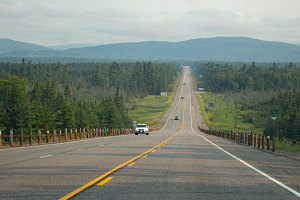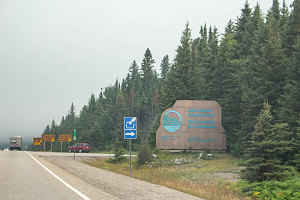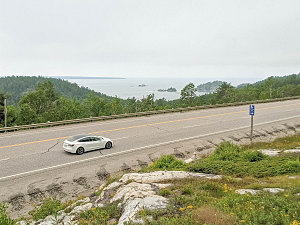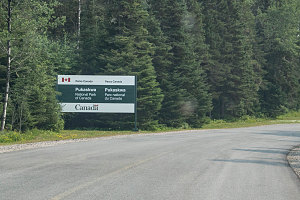Pukaskwa National Park's Coastal Trail
Introduction
Pukaskwa National Park is situated along the coastline of the world's largest (by area) inland body of water: Lake Superior. The park's boundaries encompass a large bulging lobe of land that pushes out into the Lake's northern coastline. This lobe of land is almost entirely uninhabited and without access roads. Indeed, there is only one way into the park, at its northern end: a one-way paved road that ends at the park heardquarters and public campground. There are no roads elsewhere in the park or along the park's shoreline.
Note: if you'd prefer to watch a video rather than read text and pictures, click here.
For backpackers, there is one signature route in the park: a coastal trail, extending out from the park headquarters southward, ending in a beautiful cove about halfway down the park's coastline. And this coastal trail is the subject of our attention and the reason why this trip report exists.
Puskaskwa National Park (pronounced 'puk-ah-saw') came to our attention during our
2020 traverse of nearby Lake Superior Provincial Park's coastal trail. As another summer rolled around, we decided (especially in light of continued Covid-related travel difficulties) to embark on a similar adventure -- in what seemed like an even more remote location.
The logistics of a traverse of the Pukaskwa Coastal Trail are more complicated than those of Lake Superior Provincial Park's coastal trail. Since the southern end of the trail is not accessible by road, we had to find another way to arrive at or depart from that end. We discovered that there is a local outfit,
North Shore Adventures, that offers bookable boat rides to the far end. We started a months-long dialog with owner Doug to secure a ride from the park headquarters down to the far end of the trail. And then, we would hike back over five or six days, completing the entire length of the trail and arriving back at the park headquarters on foot.

Locator Map
This year we numbered a robust eight in number: Gino, Jenn, Brian, Chris and Gillian and Katie (the Hatko family), Alana, and finally, myself. We convened on a muggy Saturday morning at the Hatko residence to begin the 1200-kilometer caravan from the Ottawa area to Pukaskwa National Park. Starting us off were fresh homemade chocolate pastries from master gastronomer Chris.
North and west we motored, following the trans-canada highway in Northern Ontario - highway 17. The Hatko family had chosen to take their electric Tesla model 3, and as a result, we were introduced to the considerations and details of charging while on a long trip. We generally stopped every 90 minutes or so. The highway 17 corridor is fairly well-equipped with charging infrastructure, and there was little inconvenience in finding an appropriate station at roughly the right location. As is recommended, the Hatkos choose to only partially charge their car at each stop, and as a result, charging throughput was higher and charge times were shorter - generally averaging less than 20 minutes each time.
As mentioned earlier, the distance from our homes to Pukaskwa National Park is about 1,200 kilometres. Although doable in a long, stretched out day, we opted for two days, stopping in the city of Sault Ste Marie at the eastern tip of Lake Superior. It was a very similar plan to last year, and in fact we stayed at the same Holiday Inn Motel (which now has a very friendly operator, I might add).
The next morning, we continued north and west on our final leg to the Pukaskwa area. Although farther along the lake's northern coastline than is Lake Superior Provincial Park, it was still a very managable four hour drive from Sault Ste Marie. We took our time, stopping for morning pastry eating at Batchawana Bay, for a view of the impressive coastal cliffs at Old Woman Bay, and for a buggy lunchtime [almost] under the wings of the big Wawa Goose.

courtesy JInnes
Heading into Superior Country

courtesy JInnes

courtesy JInnes

courtesy BConnell
Crossing through Lake Superior PP

courtesy JInnes

courtesy JInnes
Scenic Stop at Old Woman Bay
We noticed a general haze and fuzziness in the sky today (in fact, the day before, too), but as we approached the Pukaskwa area, it became noticeably denser. This was an effect of widespread forest fires farther to the west of us. By the time we arrived at a charging stop in the highway-hamlet of White River, it had thickened to a point where the clear sky was a grey-white, the sun a red dot. It was also suprisingly warm and the air smelled of campfire.
Smoky, hazy charging stop

courtesy JInnes
There's a small coastal town just north of Pukaskwa National Park - a place called Marathon (motto "built on paper, laced with gold") - which we had arranged to use as our final stopover before the backpack. After briefly stopping in at the park headquarters to register and receive a mandatory backcountry safety talk, we continued on to this town, where we had booked a final motel night. A place to finish our prep, have a final meal and shower, and prepare ourselves for the start of the big journey the following morning.
It's worth noting that all of these towns and smaller hamlets north of Lake Superior had a distinctive remote feel to them - despite the fact that they were all strung out along a major route like the Trans-Canada highway. Perhaps it is the unending boreal forest that starts and ends at each town's edge, or perhaps it is the shift in the nature of the vehicles you see, or something about the construction or layout of the towns. Or perhaps it is just the realization that there are no large metropolitan centers nearby (in other words, a purely mental feeling). In any case, the whole area definitely feels 'northern' (and yeah, I'm sure that the communities even further north, along highway 11, say, multiply that feeling again).